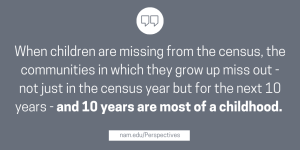What is the U.S. Census?
The U.S. Census “is mandated by the Constitution and conducted by the U.S. Census Bureau, a nonpartisan government agency. The 2020 Census counts the population in the United States and five U.S. territories (Puerto Rico, American Samoa, the Commonwealth of the Northern Mariana Islands, Guam, and the U.S. Virgin Islands).”[1] Having an accurate count every decade helps allocate federal funding for critical resources such as medical research, policymaking, funding for Medicaid, low-income housing vouchers, food assistance, school lunches, State Children’s Health Insurance, and many other programs benefitting the health and development of children. An accurate count is critical to the proper distribution of resources, however many communities continue to have misinformation and fears when it comes to completing the census.
To help battle the myths and fears, child advocates and pediatricians have teamed up to help raise awareness as to why the census is fundamental. As a trusted voice and resource for the community, several organizations such as the Federation of Pediatric Organizations and the Children’s Hospital Association have partnered with the 2020 Census to connect families with valuable resources, encourage all patients and community members to participate, and assure families their response is safe.
How Pediatricians and Hospitals are Partnering to Help
The success of the census is a community effort as much as an individual requirement and having trusted representatives such as pediatricians and child advocates encourage members to complete the census plays a key role. Parents entrust medical professionals with the care of their family and will view their advice as a trusted source. With medical professionals reiterating how their participation will help fund the hospital that provides care for their child, the affordable or free health care that helps them with vital services, and nutrition programs that help keep their family healthy, the importance of completing the census will become more relevant and important. This year, the Children’s Hospital Association shared several ways hospitals and medical professionals could encourage families to complete the census:
- Be aware there is a problem. Explain to families their participation will help lead to more funding for schools, libraries, state aid programs for health care and more.
- Get creative. Send new parents home with a onesie that reminds them to count their newborn in the upcoming census.
- Put up posters and give out flyers. From posters inside the hospital or Ronald McDonald Houses to flyers in discharge materials, children’s hospitals can bring awareness and encourage participation.
- Check out 2020Census.gov for more information and materials.
Children’s hospital teams can also post signs in a waiting room or a physician’s office and develop relationships with census workers and volunteers. [2]
How Child Advocates and Nonprofits are Helping the Community
Partnerships are key to building a safe space and encouraging parents to count everyone in their household. Organizations like First 5 Head Start have partnered with the U.S. Census to help parents understand that response to the U.S. Census is confidential and will help fund programs such as SNAP (food stamps) and health insurance, which will ensure their child remains healthy, has stable housing, and is able to continue their development. Nonprofits such as NALEO are helping traditionally undercounted areas be better informed of accessible methods for completing the census. They also help bridge the cultural gap by providing resources in several languages, partnering with local schools and organizations to amplify the importance of the US Census, and hosting local interactive activities to engage the whole family in the task.

Counting Everyone
With the nation battling a pandemic and children learning from home, access to affordable health care and school lunches have become critical to the health and development of children. By responding to the census, families can assure their children that they will have accessible health care, affordable clinics can continue to care for them, and local organizations can develop activities that will help them grow.
Fill out the U.S. Census today and share the experience with family and friends.

———-
[1] US Census Bureau. “What Is the 2020 Census?” 2020Census.gov, 2020census.gov/en/what-is-2020-census.html. (accessed July 30, 2020)
[2] Children’s Hospital Association. “Census 2020: How Children’s Hospitals Can Reduce Undercounted Children.” Childrenshospitals.org, childrenshospitals.org/Newsroom/Childrens-Hospitals-Today/Articles/2019/07/Census-2020-How-Childrens-Hospitals-Can-Reduce-Undercounted-Children?utm_source=exm&utm_medium=email&utm_campaign=cht&utm_content=071819. (accessed July 30, 2020)








